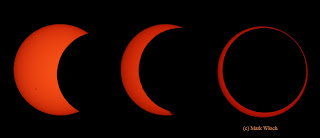Back on May 10, 1994, an annular eclipse (moon passes directly in front of the sun but is too far away in its orbit to totally cover the sun) was visible from my house in southeast Michigan. I took the day off of work and had a little eclipse party with family and neighbors on my driveway. We viewed the eclipse through my new Celestron C-8 fitted with a solar filter, and handheld mylar sun viewers (purchased from Jerry Sadowski at City Camera) held directly in front of the eyes. In astronomy there is a term saros defined as is a period of 223 synodic months(time between full moons) approximately 6585.3213 days, or nearly 18 years 11 days (10 days if there are 5 leap years in the 18 year period). One saros after an eclipse, the Sun, Earth and Moon return to approximately the same relative geometry, and a nearly identical eclipse will occur. Since a saros is not a whole number of days, the eclipse conditions occur roughly 120 degrees westward on the Earth's globe the next time around. This past Sunday May 20, 2012 one saros later the Sun, Moon and Earth aligned once again.
Although she was present for the driveway eclipse, my daughter Hannah claims to not remember it. The fact that she was two at the time may have something to do with it. So I packed up the same telescope and mylar viewers and invited her to follow me into the desert of Arizona for a birding trip and on the way home catch the eclipse in Santa Fe, NM. One more time around might do it.
Here is the progression of the event.
1) First contact- when the moon starts to cover the sun.
2) Second contact- when the moon's trailing edge reaches the sun's disk.
4) Third contact- when the moon's leading edge reaches the edge of solar disk ending the annularity.
5) Fourth contact- when the partial eclipse ends as the moon exits the solar disk. This was not visible because it occurred after sunset.
An interesting effect of the sun not being it's normal shape is that shadows take on an unusual appearance. Hannah photographed the shadow of a tree and a multitude of images of the crescent sun are projected through small gaps between the leaves.






























